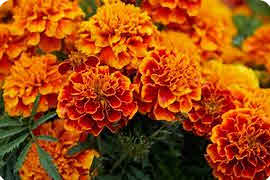Annuals
Let’s delve into the colorful world of Growing Annuals —those vibrant, short-lived plants that grace our gardens with their brilliant blooms.
What Are Annuals?
First, let’s define what we mean by “annuals.” In colder growing zones, many plants we call “annuals” are actually perennials in their native climates. However, a true annual has a brief life cycle: it germinates, grows, flowers, and dies (roots and all) within a single year. These delightful plants bring bursts of color and joy to our gardens, and many of our favorite flowers fall into this category. Think of poppies, sweet peas, sunflowers, and nasturtiums, just to name a few.
Types of Annuals
Here are some popular annuals to consider for your garden:

Marigolds
Marigolds: Prized for their bright yellow, orange, and red blooms, marigolds are easy to grow and can even repel pests.

Sunflower
Sunflowers: These cheerful giants bring sunny yellow faces to the back of your borders.

Sweet Peas
Sweet Peas: Fragrant and charming, sweet peas climb trellises and offer a delightful array of colors.

Cosmos
Cosmos: Graceful and airy, cosmos flowers sway in the breeze, attracting butterflies.

Petunias
Petunias: Available in various colors, petunias are versatile and perfect for containers or beds.

Zinnias
Zinnias: These bold, daisy-like flowers come in a rainbow of hues and thrive in full sun.
Selecting Annuals
When choosing annuals for your garden, keep these tips in mind:
- Climate Considerations: Assess your local climate and soil conditions. Some annuals thrive in full sunlight, while others tolerate partial shade. Select plants suitable for your specific garden environment. Check for more information on the climate zones.
- Rotation: Consider rotating annuals each year. This practice helps prevent the build-up of soil diseases and pests that may affect certain plants.
Caring for Annuals
To ensure your annuals bloom to their fullest potential, follow these care guidelines:
- Sunlight: Provide the right amount of sunlight based on the specific needs of each plant.
- Watering: Regular, consistent watering is essential. Keep the soil evenly moist but not waterlogged.
- Deadheading: Remove faded flowers to encourage continuous blooming.
- Fertilizing: Use a balanced fertilizer to promote healthy growth.
- Pest Control: Keep an eye out for pests and address any issues promptly.
Remember, annuals may have a brief life, but they leave a lasting impression. Enjoy their vibrant colors and celebrate the changing seasons in your garden!
-

Planting Annuals - Tricks I Use to Get More Blooms
-

How to Care for Annual Flower Pots
-

10 Must Have Annuals For Your Garden! | Best Annual Flowers For Your Garden
-

Top 15 Easy Care and Long Blooming Annuals | 15 Best Annual Flowers That Can Tolerate Full Sun
-

15 Annual flowers you should grow from seeds. This is why!
-

How To: Planting Seasonal Flowers In a Bed
-

Tips for Planting Annuals in the Landscape // Garden Answer
-

How to care for your annuals
-

7 Best Annual Flowers and Plants to Bring the 'Wow' Factor 🌻✨🌹









